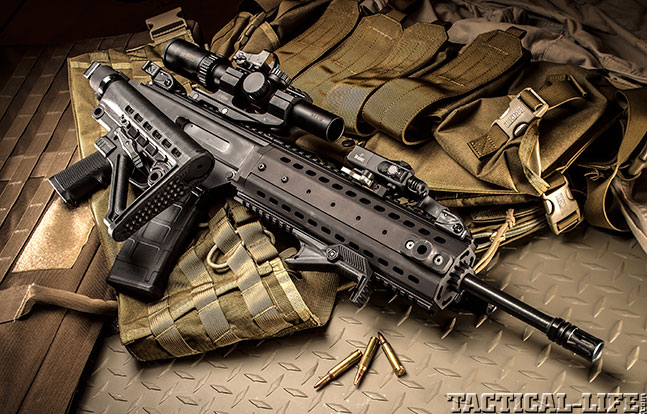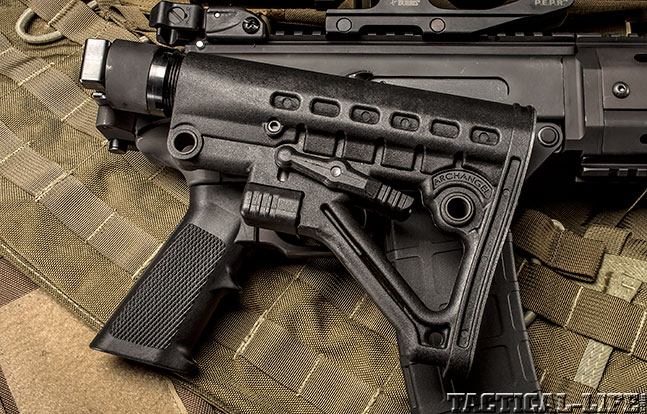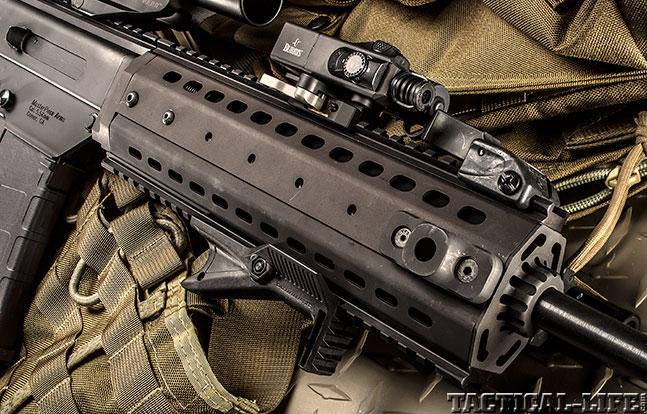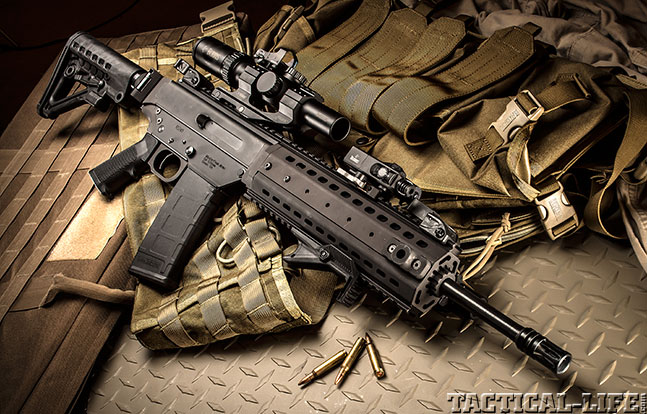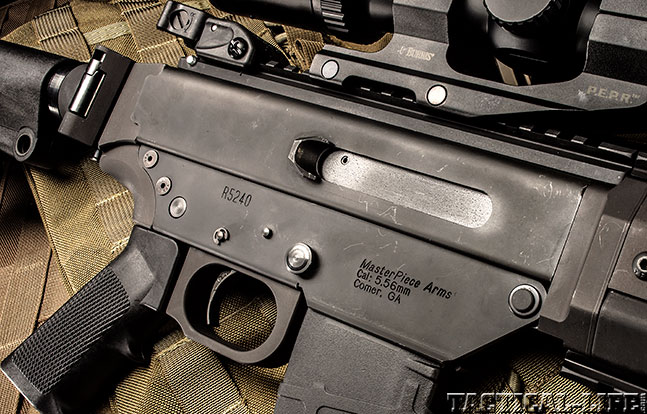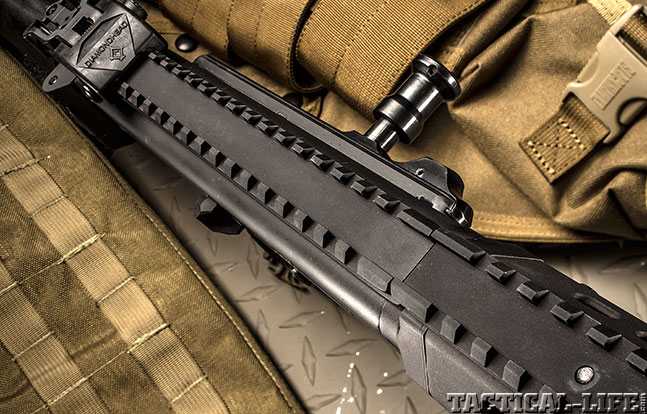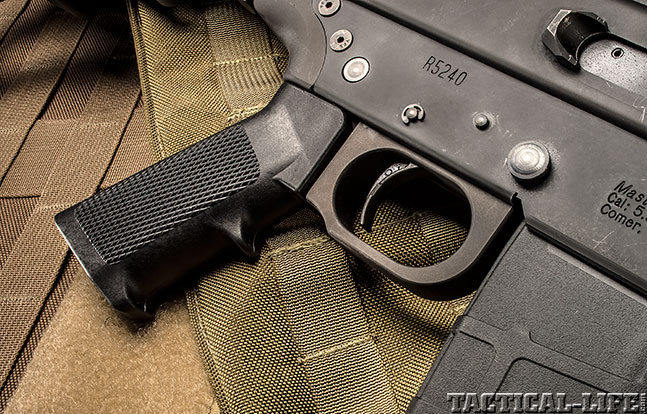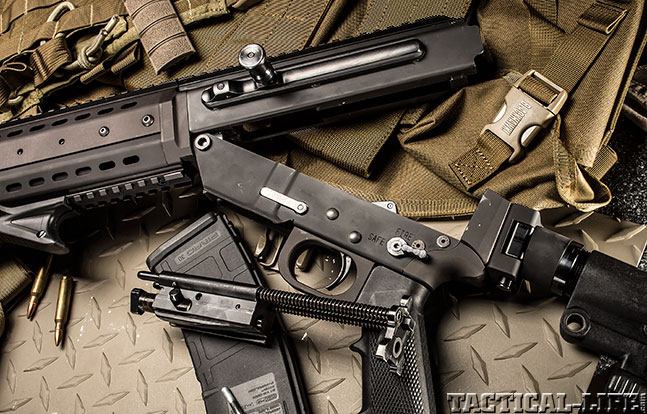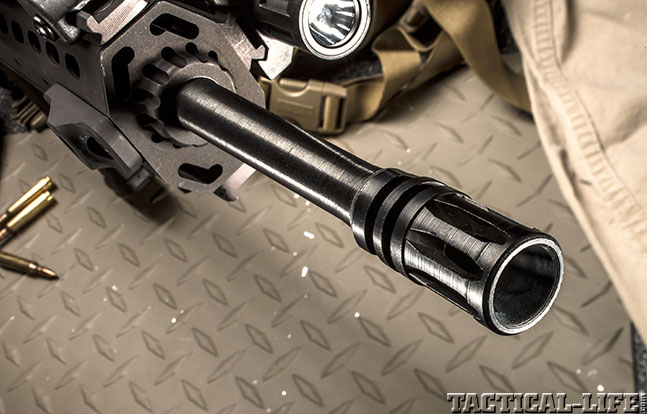When one thinks of the “black gun” it brings to mind the M16, or the civilian version of the design, the AR-15. Since its introduction in the 1960s, many improvements have been made to make the design more reliable and easier to use, but it’s basically the same as it was in the beginning.
There have been a few companies, though, that have developed guns similar to the AR-15, at least in outward appearance, but with operating systems that are decidedly different. A recent addition to that list is MasterPiece Arms of Carrollton, Ga.
The MPAR556 has a buttstock, muzzle device, pistol grip and magazine that are the same as those found on the AR. But while the MPAR556 looks similar to the AR in terms of profile and some controls, that’s where the resemblance ends.
Advertisement — Continue Reading Below
Gun Details
Out front, the birdcage-style flash suppressor is threaded to a thin-profile, black-phosphate-finished, 1-in-9-inch twist, 16-inch-long barrel. The handguard is two pieces of sheet aluminum that are fastened together with hex-head screws; the unit is then attached to the upper receiver with more hex-head screws. At the front of the handguard is a cover that surrounds the barrel and closes off the front opening in order to keep out debris. Although the handguard is ventilated, the owner’s manual cautions that it may get hot under sustained fire and recommends use of a vertical foregrip or gloves. Testing proved this warning to be correct.
Along the bottom of the handguard is a 10.5-inch accessory rail that is attached with more screws. Another accessory rail runs along the top of the handguard and butts up against an additional accessory rail that runs along the top of the upper receiver. A third, 2-inch accessory rail is attached with screws at the three o’clock position at the front of the handguard, while a quick-detach sling swivel socket is attached on the opposite side. A slant-style foregrip is attached to the bottom of the handguard and can be moved fore or aft to suit the shooter.
Advertisement — Continue Reading Below
While the rails are not built to mil-spec rail specifications, Picatinny rail attachment mounts work fine as long as the mounts have a crossbolt or locking lug that runs fully from one side to the other. The accessory rails have locking lugs only on the outside edges, so some mounts (like those made by LaRue Tactical) with a lug only in the middle will not hold securely.
Both the upper and lower receivers are sheet steel that has been black phosphate finished. The sheet metal construction no doubt helps to keep the price down. The lower has a nicely flared magazine well, and the magazine-release button is in the same relative place as it is on an AR-15, making it easy to activate with the trigger finger if the shooter is right-handed. The manual cautions that although the gun is designed to work with all AR-15 magazines, due to variances in tolerances, some will not drop free when the release is activated. Aluminum GI magazines from Brownells worked fine in the test gun, as did the supplied Magpul polymer magazine.
The safety selector is in the same place as one on an AR and worked the same way. The trigger on the test gun broke at about 8 pounds after a gritty take-up and two false breaks. The other operating control is the charging handle, which is arguably a huge improvement over the one on an AR-15. It is a non-reciprocating handle located on the left side of the upper receiver that can be operated by a right-handed shooter without having to remove his right hand from the pistol grip or moving the gun from his shoulder. If the handle is pushed inward, it also serves as a bolt forward assist. However, the test gun was not equipped with a bolt hold-open device. That deficiency has been remedied, though, and newer models of the gun have such a feature.
Advertisement — Continue Reading Below
The buttstock, with quick-detach sling swivel sockets on each side, is similar to that of an AR-15, and it’s mounted on what appears to be a commercial AR-15 receiver extension or buffer tube. It can be collapsed or extended to one of six positions and folded to the right side. This makes for a very compact and easily transported package.
Assembly
To disassemble the gun for cleaning, first double check to make sure it is unloaded. Then remove the safety pin from the top rear of the upper receiver. This allows the recoil plate tab to be pushed forward, permitting the lower to pivot down much like that of an AR-15. If the shooter wants to remove the upper completely from the lower, the pivot’s inner and outer pins are easily removed with a punch.
Advertisement — Continue Reading Below
Once the lower is rotated out of the way, the bolt carrier group, which consists of recoil plate, recoil springs, recoil spring guide rods, bolt carrier, firing pin and bolt, can be pulled from the back of the upper receiver. Then, using a roll pin punch and hammer, the firing pin retaining pin is driven from the bolt carrier, releasing the firing pin, firing pin spring and firing pin retaining plug. Next, the cam pin can be removed, which releases the bolt. The extractor can then be removed by driving its retaining pin out with a roll pin punch and hammer.
To disassemble the piston system, the flash suppressor must be removed with a wrench. Then, after unscrewing three screws on the handguard, the handguard is pulled forward off the barrel. This allows access to the piston, its springs and the gas block.
The test gun was accurate, fun to shoot and easy to control. If you want a piston gun that has the feel of an AR, but is a bit different, consider the MPAR556.
Advertisement — Continue Reading Below
For more information, visit masterpiecearms.com or call 770-832-9430.
